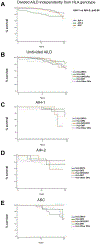Human Leukocyte Antigen Profile Predicts Severity of Autoimmune Liver Disease in Children of European Ancestry
- PMID: 33971035
- PMCID: PMC8463472
- DOI: 10.1002/hep.31893
Human Leukocyte Antigen Profile Predicts Severity of Autoimmune Liver Disease in Children of European Ancestry
Abstract
Background and aims: Genetic predisposition to autoimmune hepatitis (AIH) in adults is associated with possession of human leukocyte antigen (HLA) class I (A*01, B*08) and class II (DRB1*03, -04, -07, or -13) alleles, depending on geographic region. Juvenile autoimmune liver disease (AILD) comprises AIH-1, AIH-2, and autoimmune sclerosing cholangitis (ASC), which are phenotypically different from their adult counterparts. We aimed to define the relationship between HLA profile and disease course, severity, and outcome in juvenile AILD.
Approach and results: We studied 236 children of European ancestry (152 female [64%], median age 11.15 years, range 0.8-17), including 100 with AIH-1, 59 with AIH-2, and 77 with ASC. The follow-up period was from 1977 to June 2019 (median 14.5 years). Class I and II HLA genotyping was performed using PCR/sequence-specific primers. HLA B*08, -DRB1*03, and the A1-B8-DR3 haplotype impart predisposition to all three forms of AILD. Homozygosity for DRB1*03 represented the strongest risk factor (8.8). HLA DRB1*04, which independently confers susceptibility to AIH in adults, was infrequent in AIH-1 and ASC, suggesting protection; and DRB1*15 (DR15) was protective against all forms of AILD. Distinct HLA class II alleles predispose to the different subgroups of juvenile AILD: DRB1*03 to AIH-1, DRB1*13 to ASC, and DRB1*07 to AIH-2. Possession of homozygous DRB1*03 or of DRB1*13 is associated with fibrosis at disease onset, and possession of these two genes in addition to DRB1*07 is associated with a more severe disease in all three subgroups.
Conclusions: Unique HLA profiles are seen in each subgroup of juvenile AILD. HLA genotype might be useful in predicting responsiveness to immunosuppressive treatment and course.
© 2021 The Authors. Hepatology published by Wiley Periodicals LLC on behalf of American Association for the Study of Liver Diseases.
Figures


Similar articles
-
Autoantibody and human leukocyte antigen profiles in children with autoimmune liver disease and their first-degree relatives.J Pediatr Gastroenterol Nutr. 2014 Apr;58(4):457-62. doi: 10.1097/MPG.0000000000000245. J Pediatr Gastroenterol Nutr. 2014. PMID: 24231645
-
HLA, gut microbiome and hepatic autoimmunity.Front Immunol. 2022 Aug 18;13:980768. doi: 10.3389/fimmu.2022.980768. eCollection 2022. Front Immunol. 2022. PMID: 36059527 Free PMC article. Review.
-
Human leucocyte antigens and pediatric autoimmune liver disease: diagnosis and prognosis.Eur J Pediatr. 2016 Apr;175(4):527-37. doi: 10.1007/s00431-015-2662-x. Epub 2015 Nov 14. Eur J Pediatr. 2016. PMID: 26567543
-
Human leukocyte antigen A1-B8-DR3-DQ2-DPB1*0401 extended haplotype in autoimmune hepatitis.Hepatology. 1993 Dec;18(6):1334-7. Hepatology. 1993. PMID: 8244257
-
Autoimmune hepatitis, HLA and extended haplotypes.Autoimmun Rev. 2011 Feb;10(4):189-93. doi: 10.1016/j.autrev.2010.09.024. Epub 2010 Oct 7. Autoimmun Rev. 2011. PMID: 20933106 Review.
Cited by
-
Disease predisposition of human leukocyte antigen class II genes influences the gut microbiota composition in patients with primary biliary cholangitis.Front Immunol. 2022 Sep 20;13:984697. doi: 10.3389/fimmu.2022.984697. eCollection 2022. Front Immunol. 2022. PMID: 36203614 Free PMC article.
-
The Limitation of HLA Diversity as a Risk Factor for Pediatric-Onset Autoimmune Rheumatic Disease.J Clin Med. 2025 Jan 30;14(3):916. doi: 10.3390/jcm14030916. J Clin Med. 2025. PMID: 39941587 Free PMC article.
-
B and T cells: (Still) the dominant orchestrators in autoimmune hepatitis.Autoimmun Rev. 2024 Jul-Aug;23(7-8):103591. doi: 10.1016/j.autrev.2024.103591. Epub 2024 Aug 6. Autoimmun Rev. 2024. PMID: 39117005 Free PMC article. Review.
-
Two Concomitant Rare Extraglandular Manifestations of Primary Sjögren's Syndrome: IgA Nephropathy and Autoimmune Hepatitis.Mediterr J Rheumatol. 2024 Jan 29;35(2):305-308. doi: 10.31138/mjr.260123.ina. eCollection 2024 Jun. Mediterr J Rheumatol. 2024. PMID: 39211028 Free PMC article.
-
Genetically predicted blood metabolites mediate the association between immune cell characteristics and urolithiasis: A Mendelian randomization study and mediation analysis.Genes Dis. 2025 Jan 28;12(5):101547. doi: 10.1016/j.gendis.2025.101547. eCollection 2025 Sep. Genes Dis. 2025. PMID: 40612664 Free PMC article.
References
-
- Doherty DG, Donaldson PT, Underhill JA, Farrant JM, Duthie A, Mieli-Vergani G, et al.Allelic sequence variation in the HLA class II genes and proteins in patients with autoimmune hepatitis. Hepatology 1994;19(3):609–615. - PubMed
-
- Baharlou R, Kaghihi-Kashani A, Faraji F, Najafi-Samei M, Setareh F, Zamani F, et al.HLA-DRB1 alleles of susceptibility and protection in Iranians with autoimmune hepatitis. Human Immunology 2016;77:330–335. - PubMed
-
- van Gerven NM, de Boer YS, Zwiers A, Verwer BJ, Drenth JP, van Hoek B, et al.Dutch Autoimmune Hepatitis Study Group. HLA-DRB1*03:01 and HLA-DRB1*04:01 modify the presentation and outcome in autoimmune hepatitis type-1. Genes Immun. 2015;16(4):247–52 - PubMed
-
- Yoshizawa K, Ota M, Katsuyama Y, Ichijo T, Matsumoto A, Tanaka E, et al.Genetic analysis of the HLA region of Japanese patients with type 1 autoimmune hepatitis. J Hepatol. 2005;42(4):578–584. - PubMed
-
- Boberg KM. Prevalence and epidemiology of autoimmune hepatitis. Clin Liver Dis. 2002;6 (3):635–647. - PubMed
Publication types
MeSH terms
Substances
Grants and funding
LinkOut - more resources
Full Text Sources
Other Literature Sources
Research Materials
Miscellaneous

